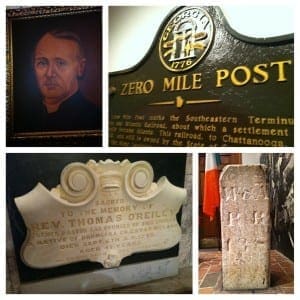A history lesson in downtown Atlanta
Published November 22, 2013
I’m a history fan. How big of a fan? Well, on my night stand now is “1776” and my bachelor weekend was spent with my best man touring New York’s American Revolution battlefields, from Saratoga National Park where Benedict Arnold made a name for himself to Fort Ticonderoga where patriots hauled the guns from that won Boston for George Washington.
So, when the opportunity came to spend Sunday, Nov. 17, with the folks at the Shrine of Immaculate Conception I was more than excited. It gave me an opportunity to see to two important artifacts of Atlanta.

From upper left, Father Thomas O’Reilly, who was in his early 30s as he lead Immaculate Conception through the Civil War; the Zero Mile Post historical marker; the stone post; and O’Reilly’s tombstone in the Shrine of the Immaculate Conception crypt.
The first was the stone post that served as mile zero for the Western and Atlanta Railroad. And since Atlanta started as a railroad hub, this is the pit of the Big Peach, so to speak. The sprawling metro region took root here.
This important artifact isn’t easy to find, which is a shame. It is tucked underneath a parking deck in a place few people would wander for the joy of it. If you are in the mood, it is underneath Wall Street, close to the intersection with Kimbell Way SE.
The marker isn’t all that impressive. It’s about knee high and is surrounded by a brick step. One side has W&A (for Western & Atlantic) and 00. The other side has W&A 138. The route from here to Chattanooga would have been marked every mile by similar posts.
But the city of Atlanta began here. Click here to see a great video to learn more.
The second was the opportunity to see the crypt of Father Thomas O’Reilly.
He was the pastor of the Immaculate Conception Church during the Civil War. There’s a bit of myth mixed with history about this native of Cavan County in northern Ireland. What is know is he played a role in preserving churches and civic buildings as the Union Army and Gen. William T. Sherman came through Atlanta on the March to the Sea.
Here’s bio information from Danny Ingram one of the event’s organizers:
According to this document Father O’Reilly arrived in Savannah, GA, in 1857 at the age of 26, which means he was born in 1831. He attended All Hallows College near Dublin, Ireland. Savannah was suffering a severe epidemic of yellow fever. Both Father O’Reilly and Father Hook, who had come with him from Ireland, contracted fever. Father Hook died. Father O’Reilly was sent to Macon and served Macon’s “mission stations.” He founded a church at Albany, GA, which was one of Macon’s mission stations. Father O’Reilly was moved to Atlanta in 1861.
His crypt is in the back of the parish fellowship hall. There are artifacts about the church and its early years kept behind a gate. You go down a short hallway to find the graves of Father O’Reilly and Father Thomas Cleary, the first native Atlantan priest to be pastor.
The church has been rebuilt twice since the Civil War, in the 1870s and after it a fire gutted it in 1982, so you aren’t standing in the same sanctuary that became a hospital ward during the war.
But what’s cool is to think how Father O’Reilly may have idly wandered past the stone marker to do some errands in the hustle of the city’s commercial hub, without giving the marker any thought.


